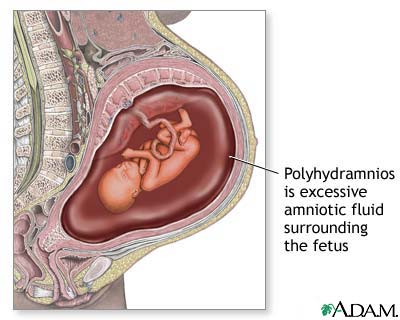Intestinal malrotation
Definition: intestinal malrotation is a congenital disorder of the intestine characterized by incomplete rotation of the intestines during fetal development which may result in acute or chronic, partial or complete bowel obstruction.
Prior to 3 months gestation, the midbowel (distal duodenum to mid-transverse colon) protrudes into the umbilical cord outside the abdominal cavity. It then re-enters the abdominal cavity where the duodenum moves to the region of the ligament of Treitz with the cecum rotating counterclockwise within the abdominal cavity to lie in the right lower quadrant. If malrotation occurs, the bowel fails to rotate after it returns to the abdominal cavity with the duodenum, jejunum, and ileum occupying the right side of the abdominal cavity and the colon occupying the left.
Malrotation may result in a failure of the right and left colon and mesenteric root to form a broad-based adherence to the posterior abdominal wall. This results in tethering of the mesentery around a narrow stalk which may twist producing a midgut volvulus. In addition, Ladd bands may cause partial or complete obstruction of the duodenum.
Age of onset: usually in the first year of life with peak before 2 months of age.
Risk factors
Intestinal malrotation is associated with:
- abdominal wall defects (diaphragmatic hernia, gastroschisis, omphalocele)
- abdominal heterotaxia
- asplenic-polyspenia congenital heart malformation syndrome anamalad
- duodenal stenosis or atresia
- small intestinal atresia
Clinical features
Bowel obstruction
- acute or chronic, partial or complete
- bilious emesis
- cyclic or recurrent vomiting and/or abdominal pain
- 25-50% of adolescents are asymptomatic
Complications
- malnutrition
- fat malabsorption
- protein-loosing enteropathy
- midgut volvulus with ischemia, necrosis of the small bowel, and shock
Investigations
Small bowel follow-thru
- initial procedure performed in a nonobstructed patient
- small bowel on the right side of the abdomen
- colon on the left side of the abdomen
- duodenojejunal junction (ligament of Treitz) lies to the right of the vertebral column
- cecum is not in the right lower quadrant
- a sharp cutoff with a curved narrowing in the distal duodenum may indicate an obstruction secondary to a volvulus
Barium enema
- malposition of the cecum – midline or left of midline in the upper abdomen (position of cecum is normal in 10% of patients)
Abdominal X-ray
- may easily miss malrotation or volvulus
- double bubble sign with obstruction
Surgery
- emergency reduction of volvulus if present
- surgical correction of the malrotation
Additional references: Rudolph’s Pediatrics (19th Edition); p. 1032-1033 (1991).






